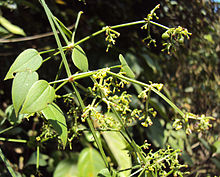munjeet
Jump to navigation
Jump to search
English[edit]

Etymology[edit]
From Hindi मंजीठ (mañjīṭh), an alternative form of मजीठ (majīṭh), from Sauraseni Prakrit 𑀫𑀁𑀚𑀺𑀝𑁆𑀞𑀸 (maṃjiṭṭhā), from Sanskrit मञ्जिष्ठा (mañjiṣṭhā).
Noun[edit]
munjeet (usually uncountable, plural munjeets)
- The plant Rubia cordifolia, or Indian madder; the dye extracted from the plant.
- 1831, Appendix I: Dying Drugs from South America: Transactions of the Society of Arts, Manufactures and Commerce, volume XLVIII, page 190:
- The colour of all is red; that of munjeet being a yellow, or orange red, that of the lac a bluish or crimson red, and that of the Bignonia a brown red.
- 1853, James Napier, Chemistry Applied to Dyeing, page 389:
- The stalks of the munjeet are very dry, light, and porous; the fracture exhibits a congeries of empty tubes. The powdered munjeet is composed of the thin and thick stalks mixed.
- 1871, Crace Calvert, Cantor Lecture II: On Dyes and Dyestuffs other than Aniline: Journal of the Royal Society of Arts, volume 19, page 815:
- He states that the munjeet root contains as much colouring matter as the Rubia tinctorum, and, according to Mr. Higgins, of Manchester, it yields from 52 to 55 per cent. of a garancine; but as it has only half the dyeing power of ordinary garancine, it cannot be employed with advantage for this purpose.
- 1918, Arthur George Perkin, Arthur Ernest Everest, The Natural Organic Colouring Matters, page 42:
- Runge, who examined the tinctorial power of munjeet, concluded that it contained twice as much available colouring matter as madder; but later experiments have shown that the colouring power is actually less.